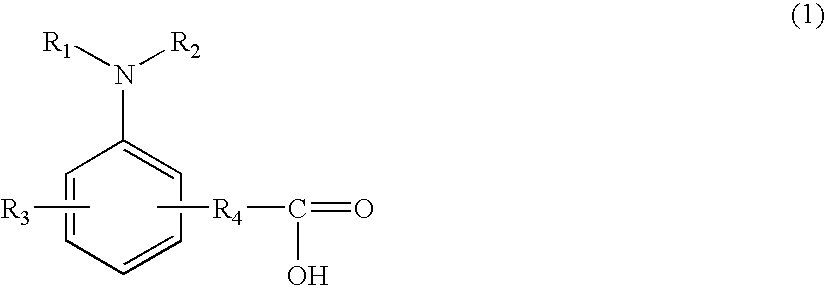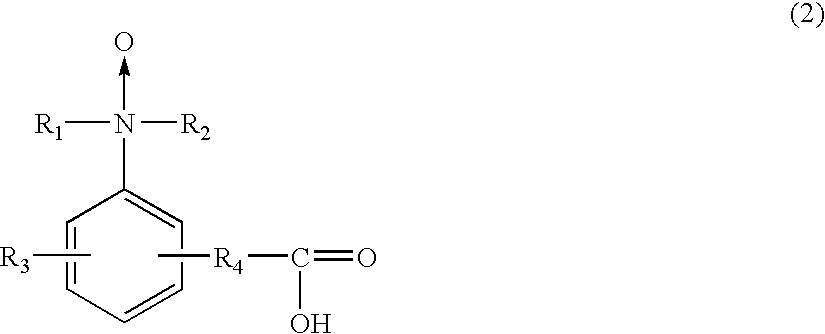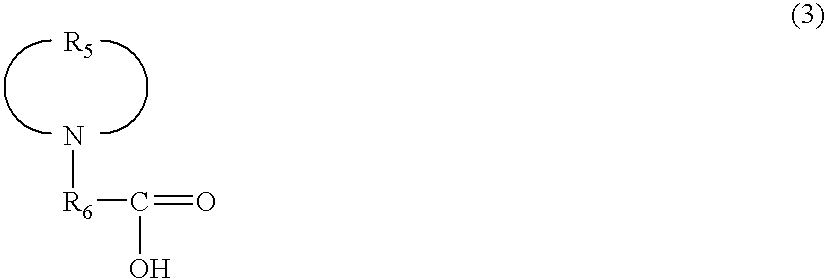Resist composition and patterning process
a composition and resist technology, applied in the field of resist composition and patterning process, can solve the problems of ped [post exposure delay], defective accompanying of resist compositions, and thickening of upper portions, and achieve excellent etching resistance, improve perpendicularity of line patterns, and improve the effect of resolution
- Summary
- Abstract
- Description
- Claims
- Application Information
AI Technical Summary
Benefits of technology
Problems solved by technology
Method used
Image
Examples
examples
[0354]The present invention will be concretely explained by describing Examples and Comparative Examples, concerning the resist composition including the amine compound or amine oxide compound having a carboxyl group and having no hydrogen atoms covalently bonded to a nitrogen atom as a basic center, without limited to the Examples.
[0355]Shown below are structural formulae of base resins (Polymers 1 and 2) and acid generators (PAG-1,2) as constituent materials of resist compositions, used in the present invention. In the following Examples, Mw and Mn represent values determined relative to polystyrene standards, as measured by gel permeation chromatography (GPC).
[0356]Solvent (A): propylene glycol methyl ether acetate (PGMEA)
[0357]Solvent (B): ethyl lactate (EL)
[0358]Further, the following compounds are amine compounds or amine oxide compounds having a carboxyl group and having no hydrogen atoms covalently bonded to a nitrogen atom as a basic center, and other inapplicable basic com...
examples 1 to 6
, and Comparative Examples 1 to 3
[0381]Resist compositions listed in Table 1 were dissolved in the listed solvents, respectively, and the obtained resist compositions were each filtered by a filter of 0.04 μm size made of nylon resin, followed by spin coating of each resist solution at a revolution speed of 2,500 rpm onto a mask blank of 152 mm square having an outermost surface made of chromium oxide nitride, into a coated thickness of 150 nm. Next, each mask blank was baked for 10 minutes by a hot plate at 90° C. Measurement of a thickness of each obtained resist film was conducted by an optical measurement device NanoSpec (manufactured by Nanometrics Incorporated). The measurement was conducted at 81 in-plane points of an applicable blank substrate except for an outer peripheral region from an outer edge to an inner extent at a distance of 10 mm therefrom, so as to calculate an averaged film thickness and a film thickness range.
TABLE 1Composition(weightCom.Com.Com.part)Ex. 1Ex. 2...
example 7 to example 15
[0386]Resist compositions listed in Table 3 were prepared, which included the amine compound having a carboxyl group and having no hydrogen atoms covalently bonded to a nitrogen atom as a basic center of the present invention, and the conventional amine compounds, and the patterning process of the present invention was performed for them in the same manner as Examples 1 through 6 to conduct evaluation of resolutions and pattern profiles thereof. Results thereof are listed in Table 4. In all Examples, excellent resolutions, pattern profiles without footing, and excellent line edge roughness were obtained.
TABLE 3Composition(weightEx.Ex.Ex.Ex.Ex.Ex.part)Ex. 7Ex. 8Ex. 9101112131415polymer-1808080808080808080PAG-1666666666PAG-2222222222Quencher-20.10.10.10.10.10.10.10.10.1Quencher-0.1————0.05———10Quencher-—0.1————0.050.050.0511Quencher-——0.1——0.0512Quencher-———0.1—0.05—0.05—13Quencher-————0.10.05——14Surfactant A0.070.070.070.070.070.070.070.070.07Solvent A470470470470470470470470470Solve...
PUM
| Property | Measurement | Unit |
|---|---|---|
| Fraction | aaaaa | aaaaa |
| Fraction | aaaaa | aaaaa |
| Fraction | aaaaa | aaaaa |
Abstract
Description
Claims
Application Information
 Login to View More
Login to View More - R&D
- Intellectual Property
- Life Sciences
- Materials
- Tech Scout
- Unparalleled Data Quality
- Higher Quality Content
- 60% Fewer Hallucinations
Browse by: Latest US Patents, China's latest patents, Technical Efficacy Thesaurus, Application Domain, Technology Topic, Popular Technical Reports.
© 2025 PatSnap. All rights reserved.Legal|Privacy policy|Modern Slavery Act Transparency Statement|Sitemap|About US| Contact US: help@patsnap.com



